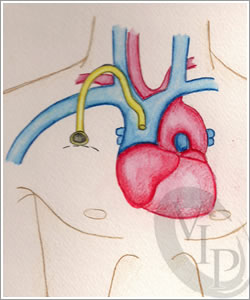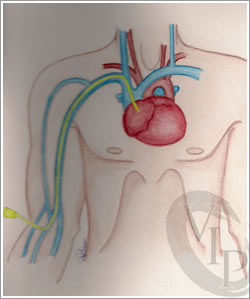Ports
A port, also known as a port-a-cath, is a small medical device that is inserted underneath a patient’s skin in order to administer medications and draw the patient’s blood. The port is made of a small metallic or plastic piece with a firm gelatinous material on the inside. This piece is placed just below the clavicle (collar bone) and is connected to a catheter that is inserted into the large vein in the chest.
A port is used to administer certain medications such as chemotherapy, TPN, and other chronic medications/infusions that are required in patients with certain diseases.
Preparing for a Port Insertion:
- A representative will call you prior to your procedure to review instructions and complete registration.
- You will need to arrange for a driver to take you home.
PRE-OP:
- Do not eat or drink anything for 12 hours prior to your procedure.
- Make sure to let your doctor know if you are on any blood thinners, including Coumadin (Warfarin), Heparin, Lovenox, Plavix or over-the-counter medications such as Aspirin, as these may need to be stopped as much as 5 days prior to the procedure.
- Tell your physician if you are, or could be, pregnant.
INTRA-OP:
- The procedure itself is not painful, however light sedation medications will be administered through an IV in order to prevent any discomfort.
- Local anesthetic will be applied to the neck and chest in order to numb the area prior to insertion of the port.
- The large vein in the neck, the Internal Jugular Vein, will be accessed using ultrasound and fluoroscopic (“live X-Ray”) guidance.
- A pocket will be created underneath the collarbone to house the port’s metallic portion.
- After the port insertion is completed, the pocket will be sewn together using absorbable stitches, which will not have to be removed and a sterile dressing will be applied.
POST-OP:
- After the procedure you will have to be monitored for approximately 1-2 hours.
- You may be sore in the neck/chest area, however you may resume your normal, light activities after 24 hours.
- It is important that you do not do any heavy lifting for a few days after the procedure.
- You will need to keep the area clean and dry for 1 week after the procedure and will need to avoid any activities that may cause you to sweat.
- The port may be used immediately after the procedure.
If you develop fever or severe pain contact our office at 352-333-7847 (7VIP) or call your referring physician. After hours or on weekends, go to the nearest emergency room or call North Florida Regional Medical Center at 352-333-4000 and ask for the Interventional Radiologist on call.
PICCS (Peripherally inserted central catheter)
A PICC line is a long, slender, flexible tube that is inserted into one of the large veins in the upper arm using ultrasound and fluoroscopic guidance.
The catheter threads all the way up the vein and the tip of the catheter terminates in the large vein in the chest, the Superior Vena Cava.
The purpose of a PICC line is to establish long-term intravenous access in order to administer medications or fluids, and draw blood.
Preparing for a PICC insertion:
- A representative will call you prior to your procedure to review instructions and complete registration
PRE-OP:
- Make sure to let your doctor know if you are on any blood thinners.
- Tell your physician if you are, or could be, pregnant.
INTRA-OP:
- Local anesthetic will be applied to the arm in order to numb the area.
- One of the large veins in the upper arm will be accessed using ultrasound guidance.
- The catheter will then be placed into the vein in the arm and the tip will be placed in the large vein in the chest, the Superior Vena Cava, using fluoroscopic (“live X-Ray”) guidance.
- The catheter will then be secured to the arm using two stitches, and a sterile dressing will be applied.
POST-OP:
- You may be discharged home immediately after the procedure and the PICC may be used right away.
- You will need to keep the area on the arm clean and dry. It is important that you do not submerge the PICC line underwater and avoid water contact during showering.
- You may resume your normal activities immediately.
If you develop fever or severe pain contact our office at 352-333-7847 (7VIP) or call your referring physician. After hours or on weekends go to the nearest emergency room or call North Florida Regional Medical Center at 352-333-4000 and ask for the Interventional Radiologist on call.
Hemodialysis Access Management
A hemodialysis or dialysis catheter, is a tube that is placed into a large vein in the body that is used to exchange blood from the patient to the hemodialysis machine and back. The catheter contains two lumens (openings); a venous lumen and an arterial lumen, although both lumens are positioned in the vein.
The veins that are typically used in hemodialysis are the large veins in either side of the neck, the Internal Jugular Veins, or the large veins in either side of the groin, the Common Femoral Veins.
For more information on preparing for hemodialysis catheter insertion:
- A representative will call you prior to your procedure to review instructions and complete registration.
- You will need to arrange for a driver to take you home.
PRE-OP:
- Do not eat or drink anything 12 hours prior to your procedure.
- Make sure to let your doctor know if you are on any blood thinners, including Coumadin (Warfarin), Heparin, Lovenox, Plavix or over-the-counter medications such as Aspirin, as these will need to be stopped prior to the procedure.
- Tell your physician if you are, or could be, pregnant.
INTRA-OP:
- The procedure itself is not painful, however light sedation medications will be administered through an IV in order to prevent any discomfort.
- Local anesthetic will be applied to the neck and chest, or groin, in order to numb the area prior to insertion of the dialysis catheter.
- The large vein in the neck, the Internal Jugular Vein, or the large vein in the groin, the Common Femoral Vein, will be accessed using ultrasound and fluoroscopic (“live x-ray”) guidance.
- The catheter will then be tunneled underneath the skin in order to help protect it from infection.
- After the dialysis catheter is inserted the catheter will be secured to your skin with a stitch and a sterile dressing will be applied.
POST-OP:
- The dialysis catheter may be used immediately after the procedure.
- After the procedure you will be monitored for approximately 1-2 hours.
- You may be sore in the neck/chest, or groin area, however you may resume your normal, light activities after 24 hours
- It is important that you do not do any heavy lifting for a few days after the procedure
- You will need to keep the area clean and dry for 1 week after the procedure and will need to avoid any activities that may cause you to sweat.
If you develop fever or severe pain contact our office at 352-333-7847 (7VIP) or call your referring physician. After hours or on weekends, go to the nearest emergency room or call North Florida Regional Medical Center at 352-333-4000 and ask for the Interventional Radiologist on call.



